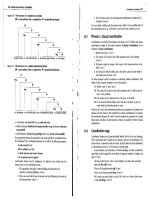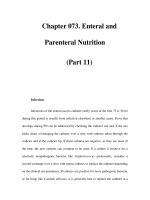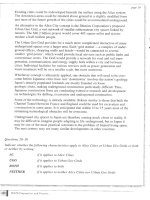Composites Manufacturing - Materials, Product, and Process Engineering Part 11 pps
Bạn đang xem bản rút gọn của tài liệu. Xem và tải ngay bản đầy đủ của tài liệu tại đây (40.27 KB, 2 trang )
© 2002 by CRC Press LLC
• The processed part should have the lowest possible void content.
• In the case of thermoset composites, the resin should be cured
uniformly and completely. Uneven curing generates residual stress
in the part. Similarly, for thermoplastic composites, uniform cool-
ing should take place to avoid residual stress build-up.
• The finished part should have minimum residual stress to mini-
mize part distortion. Part distortion or uneven shrinkage may cause
the part to go out of tolerance.
• The complete process should be achieved in the shortest possible
time. A shorter process cycle time provides higher production rate
and lower production cost.
• During the curing process of thermoset composites, the excess resin
must be squeezed out from every ply and resin distribution must
be uniform.
Methods of applying heat and pressure are different in each manufacturing
process. In the autoclave process, heat is supplied with the help of hot air
or hot nitrogen gas inside the autoclave, and pressure is applied by vacuum
bagging and by pressurizing the chamber with air. In the RTM process,
pressure is controlled by injection pressure and heat is supplied by heating
the mold. In the thermoplastic tape winding process, heat is supplied by a
laser or hot gas, and pressure is applied with the help of a compaction roller.
In the pultrusion process, heat is supplied by a heated die and pressure is
caused by narrowing the die opening.
During the solidification or curing process, a number of physical and
mechanical phenomena occur in the composite material,
1
including:
• Formation of a polymer structure, change in physical and mechan-
ical properties, change in degree of cure or crystallinity, relaxational
transitions (gelation and vitrification)
2
• Chemical and temperature shrinkage
3–5
• Stress and strain development
4–7
• Formation of kogesive defects and adhesive debonding
6,7
• Release of volatiles and void growth
8
7.4 Process Models for Selected Thermosets
and Thermoplastics Processing
For composites processing, various analytical models have been developed
to simulate the resin flow, degree of cure (for thermosets) or crystallinity (for
thermoplastics), degree of compaction and consolidation, residual stress, etc.
© 2002 by CRC Press LLC
• The processed part should have the lowest possible void content.
• In the case of thermoset composites, the resin should be cured
uniformly and completely. Uneven curing generates residual stress
in the part. Similarly, for thermoplastic composites, uniform cool-
ing should take place to avoid residual stress build-up.
• The finished part should have minimum residual stress to mini-
mize part distortion. Part distortion or uneven shrinkage may cause
the part to go out of tolerance.
• The complete process should be achieved in the shortest possible
time. A shorter process cycle time provides higher production rate
and lower production cost.
• During the curing process of thermoset composites, the excess resin
must be squeezed out from every ply and resin distribution must
be uniform.
Methods of applying heat and pressure are different in each manufacturing
process. In the autoclave process, heat is supplied with the help of hot air
or hot nitrogen gas inside the autoclave, and pressure is applied by vacuum
bagging and by pressurizing the chamber with air. In the RTM process,
pressure is controlled by injection pressure and heat is supplied by heating
the mold. In the thermoplastic tape winding process, heat is supplied by a
laser or hot gas, and pressure is applied with the help of a compaction roller.
In the pultrusion process, heat is supplied by a heated die and pressure is
caused by narrowing the die opening.
During the solidification or curing process, a number of physical and
mechanical phenomena occur in the composite material,
1
including:
• Formation of a polymer structure, change in physical and mechan-
ical properties, change in degree of cure or crystallinity, relaxational
transitions (gelation and vitrification)
2
• Chemical and temperature shrinkage
3–5
• Stress and strain development
4–7
• Formation of kogesive defects and adhesive debonding
6,7
• Release of volatiles and void growth
8
7.4 Process Models for Selected Thermosets
and Thermoplastics Processing
For composites processing, various analytical models have been developed
to simulate the resin flow, degree of cure (for thermosets) or crystallinity (for
thermoplastics), degree of compaction and consolidation, residual stress, etc.









